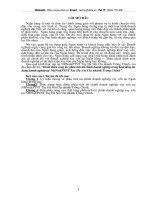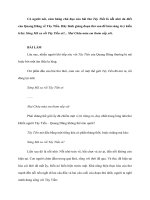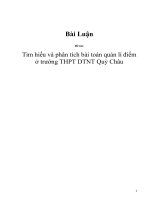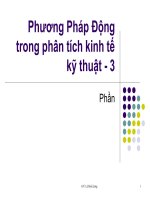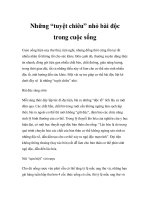Phân tích bài đọc trong toiec 10 pot
Bạn đang xem bản rút gọn của tài liệu. Xem và tải ngay bản đầy đủ của tài liệu tại đây (70.21 KB, 6 trang )
dominates the Douglas fir. After an alder canopy has closed, the Douglas fir suffers a
marked decrease in growth, often dying within several years. Even more shade-tolerant
(10) species of trees such as hemlock may remain badly suppressed beneath aggressive
young alders.
Companies engaged in intensive timber cropping naturally take a dim view of alders
suppressing more valuable evergreen trees. But times are changing; a new generation
of foresters seems better prepared to include in their management plans consideration
(15) of the vital ecological role alders play.
Among the alder's valuable ecological contributions is its capacity to fix nitrogen in
nitrogen-deficient soils. Alder roots contain clusters of nitrogen-fixing nodules like
those found on legumes such as beans. In addition, newly developing soils exposed by
recent glacier retreat and planted with alders show that these trees are applying the
(20) equivalent of ten bags of high-nitrogen fertilizer to each hectare per year. Other
chemical changes to soil in which they are growing include a lowering of the base
content and rise in soil acidity, as well as a substantial addition of carbon and calcium
to the soil.
Another important role many alders play in the wild, particularly in mountainous
(25) areas, is to check the rush of water during spring melt. In Japan and elsewhere, the
trees are planted to stabilize soil on steep mountain slopes. Similarly, alders have been
planted to stabilize and rehabilitate waste material left over from old mines, flood
deposits, and landslide areas in both Europe and Asia.
32. What does this passage mainly discuss ?
(A) Differences between alder trees and Douglas fir trees
(B) Alder trees as a source of timber
(C) Management plans for using alder trees to improve soil
(D) The relation of alder trees to their forest environments
33. The word "dense" in line 1 is closest in meaning to
(A) dark
(B) tall
(C) thick
(D) broad
34. Alder trees can suppress the growth of nearby trees by depriving them of
(A) nitrogen
(B) sunlight
(C) soil nutrients
(D) water
35. The passage suggests that Douglas fir trees are
(A) a type of alder
(B) a type of evergreen
(C) similar to sword fern
(D) fast-growing trees
36. It can be inferred from paragraph 1 that hemlock trees
(A) are similar in size to alder trees
(B) interfere with the growth of Douglas fir trees
(C) reduce the number of alder trees in the forest
(D) need less sunlight than do Douglas fir trees
37. It can be inferred from paragraph 2 that previous generations of foresters
(A) did not study the effects of alders on forests
(B) did not want alders in forests
(C) harvested alders for lumber
(D) used alders to control the growth of evergreens
38. The word "they" in line 21 refers to
(A) newly developing soils
(B) alders
(C) bags
(D) chemical changes
39. According to the passage, alders added all of the following to soil EXCEPT
(A) nitrogen
(B) calcium
(C) carbon
(D) oxygen
40. It can be inferred from the passage that alders are used in mountainous areas to
(A) prevent water from carrying away soil
(B) hold the snow
(C) protect mines
(D) provide material for housing
41. What is the author's main purpose in the passage ?
(A) To argue that alder trees are useful in forest management
(B) To explain the life cycle of alder trees
(C) To criticize the way alders take over and eliminate forests
(D) To illustrate how alder trees control soil erosion
Questions 42-50
In taking up a new life across the Atlantic, the early European settlers of the United
States did not abandon the diversions with which their ancestors had traditionally
relieved the tedium of life. Neither the harshness of existence on the new continent nor
Line the scattered population nor the disapproval of the clergy discouraged the majority
(5) from the pursuit of pleasure.
City and country dwellers, of course, conducted this pursuit in different ways. Farm
dwellers in their isolation not only found it harder to locate companions in play but
also, thanks to the unending demands and pressures of their work, felt it necessary to
combine fun with purpose. No other set of colonists took so seriously one expression of
(10) the period, "Leasure is time for doing something useful." In the countryside farmers
therefore relieved the burden of the daily routine with such double-purpose relaxations
as hunting, fishing, and trapping. When a neighbor needed help, families rallied from
miles around to assist in building a house or barn, husking corn, shearing sheep, or
chopping wood. Food, drink, and celebration after the group work provided relaxation
(15) and soothed weary muscles.
The most eagerly anticipated social events were the rural fairs. Hundreds of men,
women, and children attended from far and near. The men bought or traded farm
animals and acquired needed merchandise while the women displayed food prepared in
their kitchens, and everyone, including the youngsters, watched or participated in a
(20) variety of competitive sports, with prizes awarded to the winners. These events
typically included horse races, wrestling matches, and foot races, as well as some
nonathletic events such as whistling competitions. No other occasions did so much to
relieve the isolation of farm existence.
With the open countryside everywhere at hand, city dwellers naturally shard in
(25) some of the rural diversions. Favored recreations included fishing, hunting, skating,
and swimming. But city dwellers also developed other pleasures, which only compact
communities made possible.
42. What is the passage mainly about ?
(A) Methods of farming used by early settlers of the United States
(B) Hardships faced by the early settlers of the United States
(C) Methods of buying, selling, and trading used by early settlers of
the United States
(D) Ways in which early settlers of the United States relaxed
43. What can be inferred about the diversions of the early settlers of
the United States ?
(A) They followed a pattern begun in Europe.
(B) They were enjoyed more frequently than in Europe.
(C) The clergy organized them.
(D) Only the wealthy participated in them.
44. Which of the following can be said about the county dwellers' attitude
toward "the pursuit of pleasure" ?
(A) They felt that it should help keep their minds on their work.
(B) They felt that it was not necessary.
(C) They felt that it should be productive.
(D) They felt that it should not involve eating and drinking.
45. The phrase
thanks to" in line 8 is closest in meaning to
(A) grateful for
(B) help with
(C) because of
(D) machines for
46. The word "their" in line 8 refers to
(A) ways
(B) farm dwellers
(C) demands
(D) pressures
47. What is meant by the phrase "double-purpose" in line 11 ?
(A) Very frequent
(B) Useful and enjoyable
(C) Extremely necessary
(D) Positive and negative
48. The phrase "eagerly anticipated" in line 16 in closest in meaning to
(A) well organized
(B) old-fashioned
(C) strongly opposed
(D) looked forward to
49. Which of the following can be said about the rural diversions mentioned
in the last paragraph in which city dwellers also participated ?
(A) They were useful to the rural community.
(B) They involved the purchase of items useful in the home.
(C) They were activities that could be done equally easily in the towns.
(D) They were all outdoor activities.
50. What will the author probably discuss in the paragraph following this passage ?
(A) The rural diversions enjoyed by both urban and rural people
(B) Leisure activities of city dwellers
(C) Building methods of the early settlers in rural areas
(D) Changes in the lifestyles of settlers as they moved to the cities
Test 10
Questions 1-10
In the 1500's when the Spanish moved into what later was to become the
southwestern United States, they encountered the ancestors of the modern-day
Pueblo,
Hopi, and Zuni peoples. These ancestors, known variously as the Basket Makers,
the
Line Anasazi, or the Ancient Ones, had lived in the area for at least 2,000 years. They
were
(5) an advanced agricultural people who used irrigation to help grow their crops.
The Anasazi lived in houses constructed of adobe and wood. Anasazi houses
were originally built in pits and were entered from the roof. But
around the year 700 A.D.,
the Anasazi began to build their homes above ground and join them together
into
rambling multistoried complexes, which the Spanish called pueblos or villages.
(10) Separate subterranean rooms in these pueblos ― known as kivas or chapels ―
were set
aside for religious ceremonials. Each kiva had a fire pit and a hole that was
believed to
lead to the underworld. The largest pueblos had five stories and more than 800
rooms.
The Anasazi family was matrilinear, that is, descent was traced through the
female.
The sacred objects of the family were under the control of the oldest female,
but the
(15) actual ceremonies were conducted by her brother or son. Women owned the
rooms in
the pueblo and the crops, once they were harvested. While still growing, crops
belonged to the men who, in contrast to most other Native American groups,
planted them. The women made baskets and pottery; the men
wove textiles and crafted
turquoise jewelry.
(20) Each village had two chiefs. The village chief dealt with land disputes and
religious
affairs. The war chief led the men in fighting during occasional conflicts that
broke out
with neighboring villages and directed the men in community building projects.
The
cohesive political and social organization of the Anasazi made it almost
impossible for
other groups to conquer them.
1. What does the passage mainly discuss?
(a) The culture of the Anasazi people
(b) European settlement in what became the southeastern United States
(c) The construction of Anasazi houses
(d) Political structures of Native American peoples
2. The Anasazi people were considered "agriculturally advanced" because
of the way they
(a) stored their crops
(b) fertilized their fields
(c) watered their crops
(d) planted their fields
3. The word "pits" in line 7 is closest in meaning to
(a) stages (b) scars
(c) seeds (d) holes
4. The word "stories" in line 12 is closest in meaning to
(a) articles (b) tales
(c) levels (d) rumors
5. Who would have been most likely to control the sacred objects
of an Anasazi family?
(a) A twenty-year-old man
(b) A twenty-year-old woman
(c) A forty-year-old man
(d) A forty-year-old woman
6. The word "they" in line 16 refers to
(a) women (b) crops
(c) rooms (d) pueblos
7. The word "disputes" in line 20 is closest in meaning to
(a) discussions
(b) arguments
(c) developments
(d) purchases
8. Which of the following activities was NOT done by Anasazi men?
(a) Making baskets
(b) Planting crops
(c) building homes
(d) Crafting jewelry
9. According to the passage, what made it almost impossible for other groups
to conquer the Anasazi?
(a) The political and social organization of th Anasazi
(b) The military tactics employed by the Anasazi
(c) The Anasazi's agricultural technology
(d) The natural barriers surrounding Anasazi villages
10. The passage supports which of the following generalizations?
(a) The presence of the Spanish threatened Anasazi society.
(b) The Anasazi benefited from trading relations with the Spanish.
(c) Anasazi society exhibited a well-defined division of labor.
(d) Conflicts between neighboring Anasazi villages were easily resolved.
